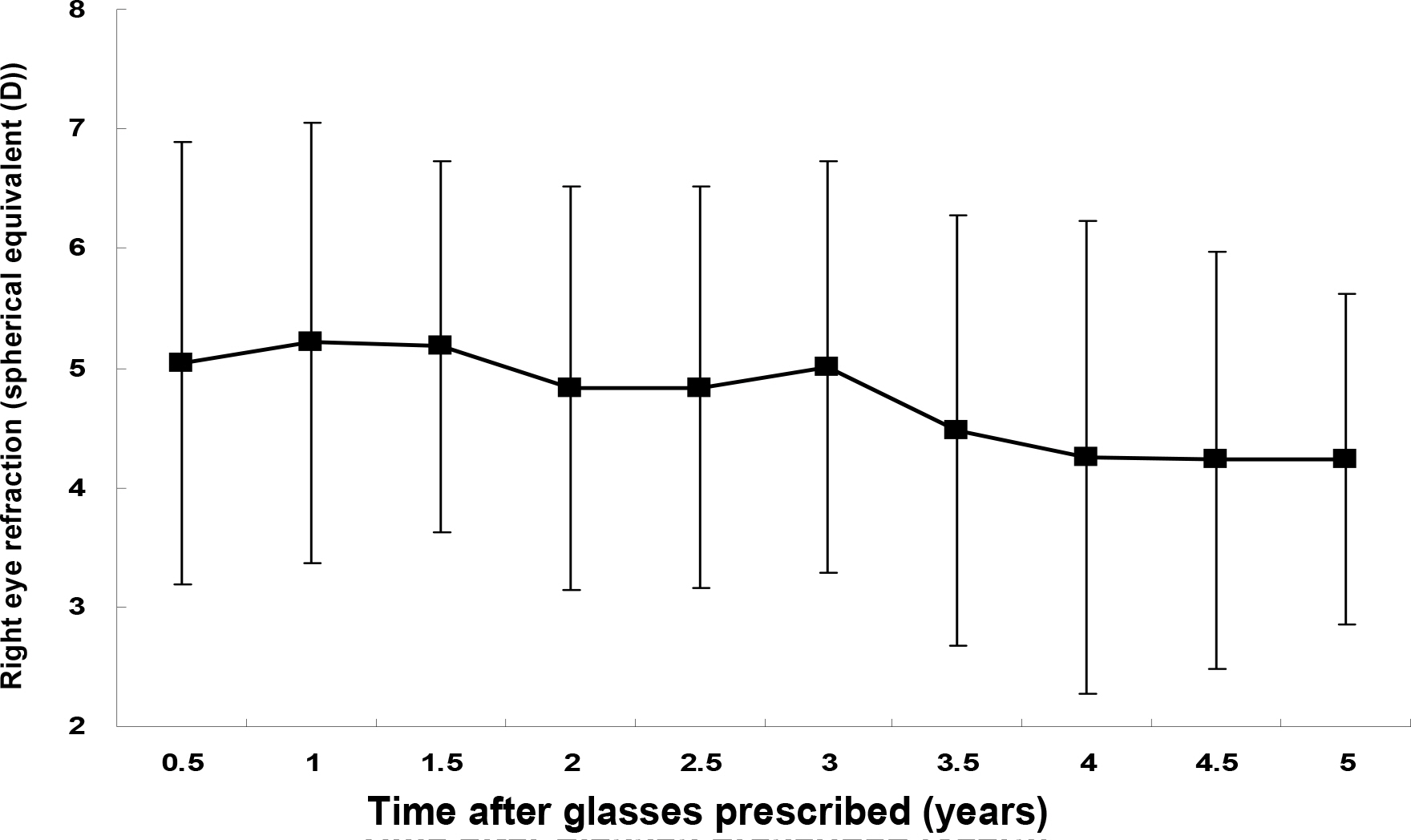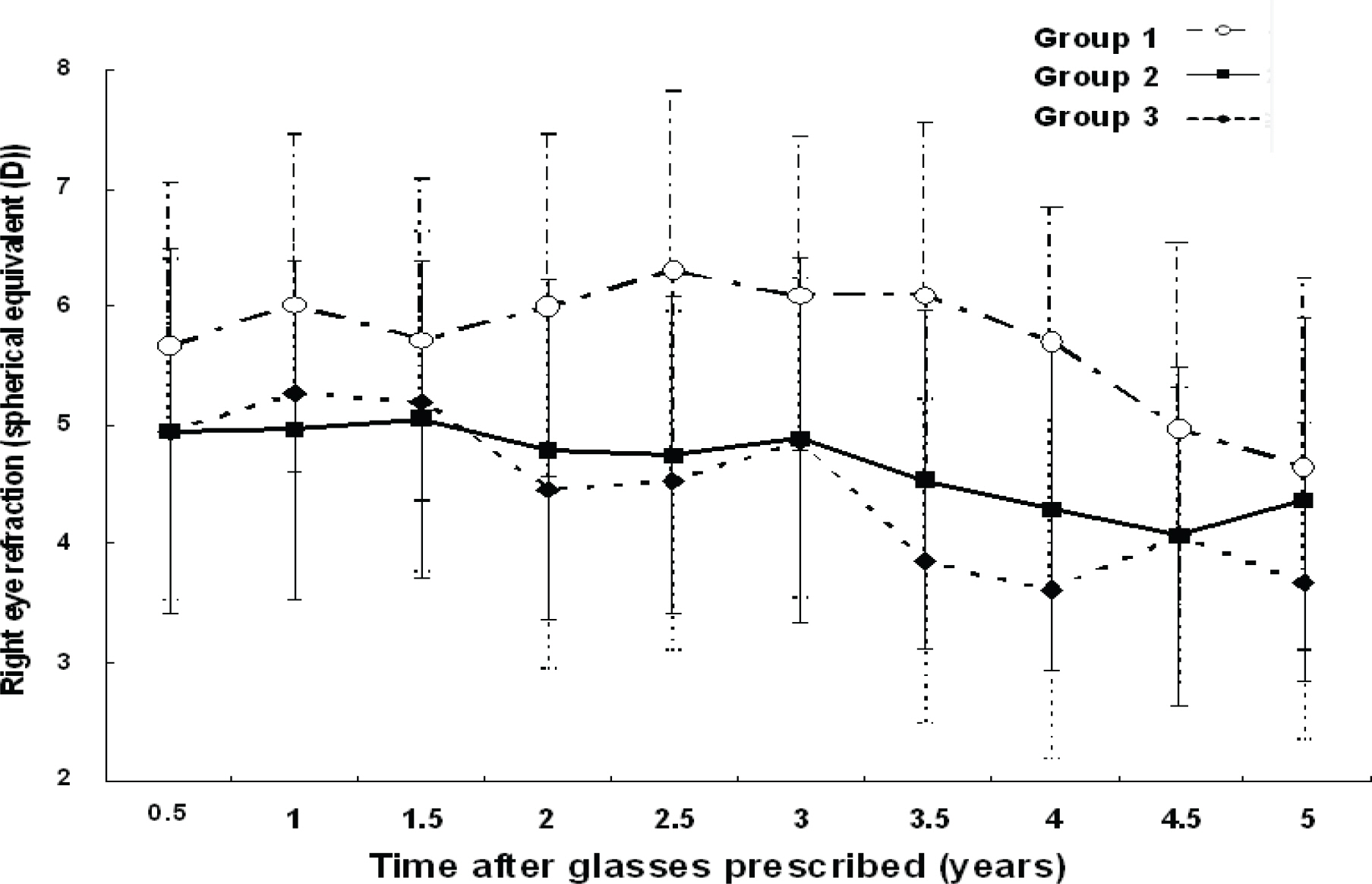J Korean Ophthalmol Soc.
2009 Feb;50(2):247-252. 10.3341/jkos.2009.50.2.247.
Effect of Age Wearing Prescription Glasses on Changes of Refractive Error in Accommodative Esotropia
- Affiliations
-
- 1Department of Ophthalmology, Samsung Medical Center, Sungkyunkwan University School of Medicine, Seoul, Korea. syoh@skku.edu
- 2Saint ary's Eye Hospital, Pusan, Korea.
- KMID: 2212058
- DOI: http://doi.org/10.3341/jkos.2009.50.2.247
Abstract
-
PURPOSE: To evaluate the effect of age wearing prescription glasses on changes in refractive error in accommodative esotropia.
METHODS
We retrospectively reviewed the charts of 63 patients with accommodative esotropia. The patients were divided into three groups according to their age when glasses were prescribed. Changes of the refractive error between the three groups were compared.
RESULTS
The mean age at the first visit was 4.1+/-2.0 years and the mean follow-up period was 5.7+/-2.7 years. In children that began wearing glasses before two years of age, the spherical equivalent (SE) refractive error initially increased, peaked 2.5 years after starting to wear glasses, and slowly decreased thereafter. In children who started wearing glasses after two years but not before four years of age the SE refractive error increased and peaked 1.5 years after starting to wear glasses. For children who began wearing glasses after four years of age the SE refractive error increased and peaked after one year. Changes in the refractive error in the youngest age group were significantly different from the other two groups (p=0.064).
CONCLUSIONS
The age when glasses are prescribed may influence normal emmetropization in accommodative esotropia. However, further studies with longer follow-ups will be needed to determine the effect of wearing glasses on the final SE refractive error.
Keyword
MeSH Terms
Figure
Cited by 1 articles
-
Clinical Outcomes of Refractive Accommodative Esotropia in Korean Adolescent Patients
Tai Kyung Kim, Nam Yeo Kang
J Korean Ophthalmol Soc. 2010;51(12):1630-1638. doi: 10.3341/jkos.2010.51.12.1630.
Reference
-
References
1. Von Noorden GK. Binocular vision and ocular motility. 6th ed.St. Louis: Mosby;2002. p. 311–55.2. Raab EL. Etiologic factorsin accommodatie esodeviation. Trans Am Ophthalmol Soc. 1982; 80:657–94.3. Raab EL, Spierer A. Persisting accommodative esotropia. Arch Ophthalmol. 1986; 104:1777–9.
Article4. Repka MX, Wellish K, Wisnicki HJ, et al. Changes in refractive error of 94 spectacle treated patients with acquired accommodative esotropia. Binocular Vision. 1989; 4:15–21.5. Rutstein RP, Marxh-Tootle W. Clinical course of accommodative esotropia. Optom Vis Sci. 1998; 75:97–102.
Article6. Swan KC. Accommodative esotropia long range follow-up. Ophthalmology. 1983; 90:1141–5.
Article7. Kim DJ, Chun BY, Kwon JY. Five-year follow-up results of refractive accommodative esotropia. J Korean Ophthalmol Soc. 2007; 48:315–20.8. Lambert SR, Lynn MJ. Longitudinal changes in the spherical equivalent refractive error of children with accommodative esotropia. Br J Ophthalmol. 2006; 90:357–61.
Article9. Sohn HJ, Paik HJ. Clinical features of refractive accommodative esotropia according to the age of onset. J Korean Ophthalmol Soc. 2006; 47:941–6.10. Koretz JK, Rogot A, Kaufamn PL. Physiological strategies for emmetropia. Trans Am Ophthalmol Soc. 1995; 93:105–18.
Article11. Troilo D. Neonatal eye growth and emmetropization: A literature review. Eye. 1992; 6:154–60.12. Atkinson J, Anker S, Bobier W, et al. Normal emmetro-pization in infants with spectacle correction for hyperopia. Invest Ophthalmol Vis Sci. 2000; 41:3726–31.13. Atkinson J, Braddick O, Robier B, et al. Two infant vision screening programmes: prediction and prevention of strabismus and amblyopia from photo- and videorefractive screening. Eye. 1996; 10:189–98.
Article14. Hung LF, Crawford ML, Smith EL. Spectacle lenses alter eye growth and the refractive status of young monkeys. Nat Med. 1995; 1:761–5.
Article15. Schaeffel F, Glasser A, Howland HC. Accommodation, refractive error and eye growth in chicks. Vision Res. 1988; 28:639–57.16. Smith EL, Hung LF. The role of optical defocus in regulating refractive development in infant monkeys. Vision Res. 1999; 39:1415–35.17. Aurell E, Norsell K. A longitudinal study of children with a family history of strabismus: factors determining the incidence of strabismus. Br J Ophthalmol. 1990; 74:589–94.
Article
- Full Text Links
- Actions
-
Cited
- CITED
-
- Close
- Share
- Similar articles
-
- Refractive Accommodative Esotropia Associated with Mild Hyperopia
- The Clinical Course of Esotropia Associated with Hypermetropia after Initial Wearing of Glasses
- Long-Term Changes of Hyperopic Refractive Error in Refractive Accommodative Esotropia
- Clinical Features of Refractive Accommodative Esotropia according to the Age of Onset
- Clinical Characteristics of Accommodative Esotropia with Successful Wearing out of Glasses




